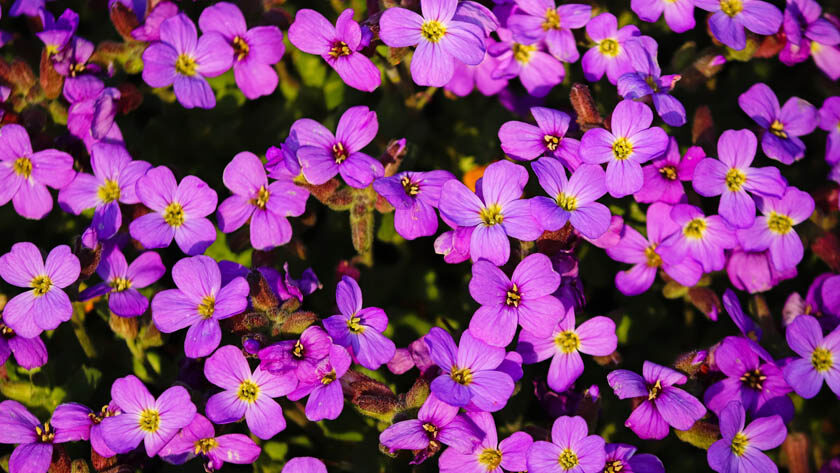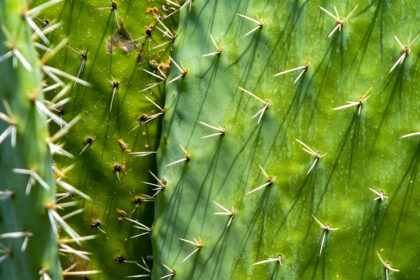Most of the time the flowers that beautify our garden do not have to be the most imposing in size. Below I will present you with 10 types of plants with small flowers that will surely conquer you.
1. Baby’s Breath (Gypsophila)
2. Forget-Me-Not (Myosotis)
3. Lobelia (Lobelia erinus)
4. Snow-In-Summer (Cerastium tomentosum)
5. Sweet Alyssum (Lobularia maritima)
6. Aubrieta
7. Lily of the valley
8. Campanula
9. Lavender
10. Calluna
- Baby’s Breath (Gypsophila)

Gypsophila is a genus of flowering plants in the carnation family, Caryophyllaceae.
Don’t forget to plant gypsophila if you plan to make your cut flower garden. This plant is ideal for making our bouquets more beautiful, on which we will make our garden.
These plants with small flowers are widespread in floral arrangements because they make perfect floral harmony with the other flowers due to their size and shape.
I give you a tip, do not throw away the gypsophila flowers after they start to dry out because you can use them in dried flower arrangements. In this way, we can enjoy this plant for a long time.
Gypsophila loves the sun, so it will need to be planted in a sunny area of our garden. As for the soil, it should be one with good drainage, preferably a sandy one. Watering of the plant should be done in moderation, more when the plant is young to ensure its attachment and less when it reaches maturity. These plants generally prefer a warm climate, but some species can withstand even lower temperatures.
Depending on its type, annual or perennial, the propagation of gypsophila is done by seeds or cuttings. We can sow the seeds from March to April, and in May, we will enjoy its flowering.
2. Forget-Me-Not (Myosotis)

Forget-Me-Not (Myosotis) is a species of flowering plant in the family Boraginaceae, native to Europe.
The flower of forgetfulness is part of the category of plants with small flowers. Even if the flowers are small, they attract the eyes of flower lovers very quickly due to their color it has. The flowers I don’t forget are most often found in blue, but they also exist in pink and white. These perennials appear year after year, where the seeds have shaken.
They are perfect for gardens, especially if we have several alleys or curbs, thus forming an ideal setting for the other flowers in our garden. to be observed.

The name of this plant is related to several meanings, but one, in particular, attracted my interest. It is said that long ago, in medieval times, a knight who, before drowning, threw his girlfriend a bouquet of blue flowers that were on the shore started and to shout, “Don’t forget me.” Thus the flowers of not forgetting me became a symbol of remembrance.
The flower I don’t forget is a plant that likes the sun. But not in abundance. The soil must be rich and very drained, especially if exposed to the sun. As for watering, it must be done constantly and slightly lowered.
The multiplication of the plants is done through seeds, these being formed after the flowers have passed.
3.Lobelia (Lobelia erinus)

Lobelia is a genus of flowering plants comprising 415 species, with a subcosmopolitan distribution primarily in tropical to warm temperate regions, with a few species extending into cooler temperate regions.
Lobelia is another small plant that is perfect for integrating into a flower arrangement in hanging pots. The most common is the vibrant blue color that gives a splash of color to any place I plant it. It is a plant that blooms from spring to autumn and can be grown in hanging pots, planters, or even in the garden. They are found in several shades, in addition to blue, such as white, pink, purple, and red.
Lobelia loves moist soil, with a slightly shadier area so that the tiny flowers last as long as possible in the warm season. It multiplies by seeds that are formed after the blooms pass.
4.Snow-In-Summer (Cerastium tomentosum)

Snow in summer is one of those little flowering plants that will surely make you fall in love when you see it.
If you have larger empty earthenware in your garden and don’t know what to cover, this is a great way to fill them.
Being a perennial plant, you will enjoy it every year. In addition to the small white flowers, the leaves with a woolly texture and a silvery color are attractive, hence their name. These plants bloom in late spring.
Snow In Summer loves to be planted in a sunny area of the garden, and the soil should be well-drained and preferably acidic. As for watering it, it is drought tolerant, so it does not require much water. Being drought-tolerant means, it doesn’t need fattening either.
5. Sweet Alyssum (Lobularia maritime)

Lobularia maritima is a species of low-growing flowering plant in the family Brassicaceae. Its common name is sweet alyssum or sweet alison, also commonly referred to as just alyssum.
This tiny flowering plant is ideal for planting in gardens, other flowering plants, or even in the park, especially near curbs or gravel areas. It is a perennial plant that is quickly caught by shaking seeds and practicing forming a living mulch. It is prevalent in white, purple, and lilac.

If the sun reaches alyssum as much as possible, we will surely enjoy a bed of color and a fabulous smell. The soil must be moist and very well-drained, and the plant must be well watered if the temperatures are high and fertilizer and he doesn’t need it.
6. Aubrieta

Aubrieta (often misspelled as Aubretia) is a genus of about 20 species of flowering plants in the cabbage family Brassicaceae. The genus is named after Claude Aubriet, a French flower painter. It originates from southern Europe east to central Asia but is now an everyday garden escape throughout Europe.
Aubrieta is a perennial, alpine plant, but it is also prevalent in people’s gardens, forming a spectacular carpet of tiny blue or purple flowers in spring.
Like other small flowering plants, it loves to be planted near paths, curbs, or rocky areas in our garden. Aubrieta must be planted in full sun to grow as beautiful as possible, and the soil should be similar to that of its natural, alkaline habitat. It does not need much watering, and I like to grow in more excellent areas.
7. Lily of the valley

Lily of the valley (Convallaria majalis), sometimes written lily-of-the-valley, is a woodland flowering plant with sweetly scented, pendent, bell-shaped white flowers borne in sprays in spring. It is native throughout the cool temperate Northern Hemisphere in Asia and Europe but is considered generally invasive in parts of North America.
Indeed, the Lily of the valley could not be missing from the category of plants with small flowers. Lily of the valley is a very, very special flower, mainly due to its shape of the bell and the fragrance that surrounds our unforgettable garden.
If we have shady areas in our garden or areas with trees and do not know what to plant, Lilly of the valley is the best choice.
It loves shade, so it will need very well-drained soil, even clayey, to grow. Being a plant blooming in spring, it does not tolerate high temperatures.
8. Campanula

Campanula is one of several flowering plants in Campanulaceae, commonly known as bellflowers. They take their common and scientific names from the bell-shaped flowers — campanula is Latin for “little bell.”
Where you have a crack in an old fence or the pavement, a bell will be able to grow there. The campanula is also a small flower that beautifies our garden with its vibrant purple color. It is a perennial plant that will decorate our garden every spring with its purple flowers in a bell shape.

Campanula should be planted in an area of the garden with the sun, with drained soil and moderate watering. It would be good to sprinkle mulch around them to maintain humidity and campanula, providing a beautiful garden decoration.
9. Lavender

Lavandula (common name lavender) is a genus of 47 known species of flowering plants in the mint family, Lamiaceae. It is native to the Old World and is found in Cape Verde and the Canary Islands, and from Europe across to northern and eastern Africa, the Mediterranean, and southwest Asia to India.
I think we’ve all seen those purple-lined chains instantly steal your eye. Lavender is also about its beauty, and we can say that lavender is a species of plant with small purple flowers that is multifunctional. You can find it both in floral arrangements with live or dried flowers and in the cosmetics or perfume industry.
To have a bush full of small purple flowers, we need to plant lavender in a place with plenty of sun and well-drained, alkaline soil that enhances the unique scent of lavender.
10. Calluna

Calluna vulgaris, common heather, ling, or simply heather, is the only species in the genus Calluna in the flowering plant family Ericaceae. It is a low-growing evergreen shrub growing to 20 to 50 centimeters (8 to 20 in) tall, or rarely to 1 meter (40 in) and more elevated. It is found widely in Europe and Asia Minor on acidic soils in open sunny situations and moderate shade.
If you want a plant that will beautify your garden towards the end of summer or the beginning of autumn, the hawthorn is that flower. Small flowers in pink, purple or white will decorate your garden. It needs sun to bloom and a slightly sandy, well-drained soil, and it prefers a wetter and cooler climate to have a lush growth.





